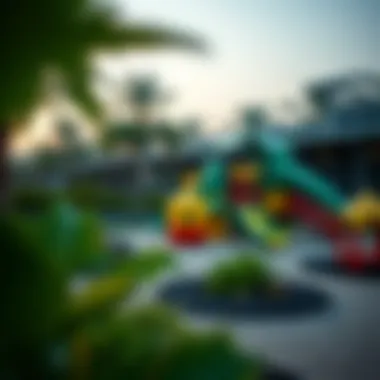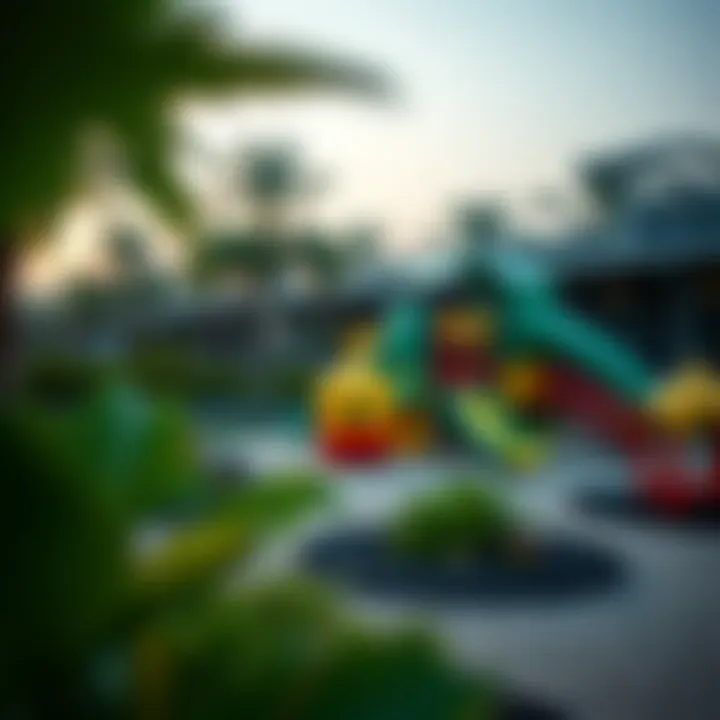The Role of Play Areas in Dubai's Real Estate Market


Intro
In the bustling and ever-evolving landscape of Dubai's real estate market, one might often overlook the significant impact that play areas can have on property value and community dynamics. These communal spaces carry more weight than one might assume. They form the backdrop of family life, shaping experiences and forging connections among residents. As families flock to Dubai for its myriad opportunities, the presence of a well-designed play area becomes a crucial factor in their housing choices.
Dubai has witnessed a surge in its real estate development over the past decade, transforming itself into a global hub for expats. The vibrant neighborhoods are appealing not just for luxury apartments and villas but for the lifestyle they offer. Setting the stage for enriching experiences, play areas add a layer of attractiveness to residential properties that investors and homebuyers often find hard to resist.
As we explore this concept intricately, it’s essential to look into what the inclusion of play areas means for the market. The understanding of property value isn't limited to square footage. Instead, it incorporates the lifestyle amenities available, particularly spaces tailored for children and families. What follows is an examination of current trends and insights that clarify just how significant play areas are to prospective buyers and the overall market health.
Intro to Play Areas
The essence of play areas stretches far beyond just a patch of grass with swings. They are the heartbeat of urban neighborhoods, especially in bustling cities like Dubai, where the blending of culture and modernity creates unique living landscapes. As developers and investors increasingly recognize the appeal of integrating communal play spaces into residential projects, understanding the underlying importance of these areas becomes essential.
Defining Play Areas
Play areas typically comprise designated spaces designed for recreation and social interaction. This can include everything from parks with playground equipment to multi-functional recreational zones. In the context of Dubai, these play areas can even range from traditional facilities to modern, tech-enabled spaces that encourage innovative forms of play. These recreational havens serve not just children; they provide everyone with an opportunity to engage in various activities—outdoor fitness equipment, community gardens, or even splash pads for families. It's a blend of fun and functionality.
Importance in Urban Development
When considering urban development, the significance of play areas cannot be overstated. They play a crucial role in creating a livable environment and can greatly enhance the quality of life for residents.
- Health Benefits: Access to recreational spaces encourages physical activity—essential in today’s sedentary lifestyle. A jogger's path or a space for yoga brings fitness options to the doorstep.
- Social Cohesion: Play areas foster community interaction. They become social hubs where neighbors meet, friends gather, and families bond, breaking down the barriers that often exist in a fast-paced urban environment.
- Increased Property Value: Homes near well-designed play spaces or parks often command a premium. Real estate buyers often look for properties that provide conveniences—proximity to communal or green spaces is a huge draw.
"Investing in play areas is essentially investing in the future of communities and their residents."
Play Areas and Real Estate Value
The role of play areas within the real estate framework of Dubai cannot be overstated. These spaces are not mere patches of grass with swings and slides; they symbolize the heart of community living, influencing both buyer preferences and property valuations. In a city known for its opulence and rapid development, play areas serve as vital components that enhance real estate prospects. They impact property appeal and are increasingly becoming a distinguishing factor for potential homebuyers and investors alike.
Impact on Property Appeal
When it comes to assessing property appeal, play areas stand tall among various other influencing factors. Homes situated near well-designed play areas tend to have a competitive edge in the housing market, and this trend is growing stronger.
Many buyers prioritize proximity to family-friendly amenities, and play areas encapsulate that. They offer safe spaces for children to engage, socialize, and develop physically. Properties in neighborhoods featuring well-maintained parks or recreational spaces often attract families who are willing to pay a premium.
Moreover, these amenities can significantly enhance the aesthetic appeal of neighborhoods. Well-designed play areas contribute to the overall landscape, making residential areas more visually inviting and appealing. This visual impact can translate into higher demand for properties nearby, thereby increasing their market value.
The correlation between property appeal and play areas can be viewed through various lenses.
- Safety and Convenience: Buyers with children appreciate the convenience of nearby recreational facilities that come with a sense of safety, reducing the need for long commutes to find suitable play spaces.
- Community Engagement: Properties in areas with play spaces often see a more engaged community, fostering relationships and a neighborhood identity. This connection can sway buyers who prioritize community involvement in their lives.
- Future Proofing: Homebuyers view proximity to play areas as an investment in their family's future. As children's needs evolve, having access to versatile play spaces allows for continued recreational opportunities that can enrich their upbringing.
"Play areas serve as the nexus of community life and values, enriching neighborhood identity while driving property value upward."
Market Trends Related to Play Areas
As the dynamics of the real estate market in Dubai continue to shift, understanding the trends related to play areas gives insight into consumers’ preferences and developers’ strategies. The demand for properties close to play amenities is a decisive factor in trends influencing real estate pricing and investment opportunities.
- Rising Interest in Family-Friendly Developments: An observable trend is the increasing interest in family-oriented developments. Builders are now recognizing the demand for projects that incorporate play areas or recreational facilities. This shift not only meets market demand but helps position the development favorably in comparison to others lacking such amenities.
- Integrated Community Planning: Modern developments frequently include play areas as part of integrated community designs. Investors are more inclined to consider those projects that showcase a holistic approach to living, which involves access to recreational spaces.
- Long-term Investment Considerations: Investors see the value in properties that may serve as generational assets. Access to play areas ensures continuous demand; therefore, investors view these neighborhoods as safer bets for future returns.
As neighborhoods in Dubai evolve, the relationship between play areas and market trends only appears to strengthen, making it essential for real estate stakeholders to stay informed about these changing dynamics. With play areas at the forefront of community engagement and property value enhancement, understanding their importance provides a significant advantage in the competitive real estate landscape.
Design Considerations for Play Areas
When it comes to establishing play areas in Dubai, several design considerations come into play that can optimize both functionality and appeal. Using a thoughtful approach in the design phase ensures that these spaces cater to diverse needs, enhancing community value and attracting potential buyers or investors. Here’s a closer look at key elements that should be prioritized in the planning and design of play areas.
Space Utilization Techniques
Efficient use of space is essential when designing play areas, particularly in a bustling city like Dubai where land comes at a premium. Considerations for maximizing usability include:
- Multi-functional Spaces: Creating areas that can be used for various activities helps in making the most out of limited real estate. For instance, an open lawn can serve as a picnic spot, sports field, or performance stage, thereby drawing in different groups of people.
- Layered Design: Incorporating vertical elements, such as climbing structures or tiered seating, can add layers to the play area. This not only stimulates physical activity but also gives a more dynamic feel to the space, making it visually appealing.
- Flexible Layouts: Design elements should allow for flexibility. Movable play equipment can cater to varying age groups and events, ensuring the space adapts to the community’s needs.


In essence, smart space utilization techniques can transform a simple play area into a vibrant community hub.
Inclusive Design Principles
In Dubai’s diverse environment, inclusive design principles must be a priority. These principles ensure that play areas serve everyone, regardless of age or ability. Here’s what should be taken into account:
- Accessible Entrances: Design pathways that can easily accommodate strollers, wheelchairs, and mobility aids. This means thinking about slopes, surfaces, and the overall layout to ensure equal access for all.
- Varied Equipment: Include play structures that cater to different skill levels. Items like sensory panels and wheelchair-accessible swings ensure that all individuals can enjoy the area together.
- Engaging Environments: A play area that stimulates interaction among all users promotes a sense of belonging. Installing diverse play elements encourages children to engage with peers, fostering social skills.
Embracing inclusive design not only elevates the play area’s aesthetic but also enhances the sense of community, crucial for potential buyers when considering property value.
Integration with Natural Landscapes
The integration of play areas with natural surroundings is another vital design consideration. By conserving and incorporating existing natural elements, developers can create a harmonious environment that attracts residents:
- Preserving Flora: Retaining existing trees and plants can provide shade and natural beauty. Additionally, these trees can act as landmarks, creating identity within a neighborhood.
- Water Features: Including natural water elements such as ponds or streams can not only beautify the area but also create engaging play experiences. Children are often drawn to water for its calming effects and opportunities for exploration.
- Nature Trails: Creating paths that wind through natural landscapes can encourage exploration and outdoor activity. It connects children and families with the surroundings, making play areas more appealing.
In sum, merging play areas with nature not only beautifies spaces but also enriches environmental interaction, which can provide substantial benefits for property investment in the long run.
Integrating well thought-out design elements and engaging the community's needs in Dubai can significantly enhance the prospects of real estate investments.
Through a strategic approach to design, play areas can transform residential communities, improving quality of life while attracting more people to live and invest in these neighborhoods.
Safety Regulations and Standards
When it comes to play areas in Dubai, safety can’t be emphasized enough. These spaces must not only entertain but also safeguard the well-being of their users. For investors and developers, understanding safety regulations and standards is crucial. Observing these standards ensures that play areas are built securely and sustainably, enhancing the attraction of nearby properties while also meeting community expectations.
Local Compliance Requirements
Dubai has specific regulations governing the construction and management of play areas. Understanding these local compliance requirements is essential for any real estate development project. The Dubai Municipality oversees the adherence to these regulations, which includes guidelines for materials used, design specifications, and maintenance protocols.
For instance, play surfaces should be soft and shock-absorbent, reducing the chances of injury from falls. Equipment must comply with national standards set out in the UAE's safety guidelines. Developers must also ensure the layout of the playground allows for easy supervision, which is particularly vital in busy urban settings.
Moreover, it’s not just about what's on paper. Regular inspections are mandated to ensure ongoing compliance with safety standards. This ongoing commitment to safety can significantly boost the appeal of residential properties, as parents prioritize neighborhoods where safety standards are a clear priority.
International Safety Standards
In addition to local regulations, international safety standards also play a significant role in the development of play areas in Dubai. Adhering to guidelines set forth by organizations like ASTM International and the International Play Equipment Manufacturers Association (IPEMA) not only ensures safety but also elevates the credibility of any project.
Globally recognized standards often entail rigorous testing for equipment durability, usability, and overall safety. Inclusion of these standards in a play area design sends a strong message to potential buyers and investors about quality and safety. It involves elements such as:
- Age-appropriate design: Ensuring facilities cater to different age groups minimizes the risk of accidents.
- Environmentally safe materials: Utilizing non-toxic, durable materials signifies a commitment to community health and safety.
- Comprehensive safety audits: International guidelines recommend conducting thorough assessments to preemptively address potential hazards.
Incorporating these international standards into local practices not only reassures residents but can also elevate the overall quality of a new development in Dubai. It reflects a commitment to best practices that can resonate positively in the evolving real estate market.
Investing in playground safety is not merely about compliance; it is about trust. Homebuyers are more likely to invest in neighborhoods with safe, well-maintained play areas that reflect a community’s dedication to its residents.
Understanding the safety regulations and international standards allows developers to position their projects effectively in the market. This attention to detail not only meets compliance but enhances the overall perception of the development in the eyes of prospective buyers and the community at large. Residents look for neighborhoods that prioritize safety in lifestyle choices, making compliance a non-negotiable aspect of real estate marketing.
Psychological Benefits of Play Areas
When one thinks about play areas, the immediate visuals may often be the swings swaying in the breeze or children running around, but there’s more than meets the eye. These spaces, especially in a cosmopolitan hub like Dubai, hold tremendous psychological significance. They do not just serve as venues for physical activity; they’re essential for holistic development and nurturing community connections. By integrating well-designed play areas into the urban landscape, developers can significantly enhance not only residential prospects but also the life quality of the inhabitants.
Enhancing Child Development
Children are like sponges, soaking up experiences and information from their surroundings. Play areas provide an important environment for emotional, cognitive, and social growth. For instance, when children engage with peers in a playground setting, they learn to negotiate, share, and resolve conflicts, vital skills that last a lifetime. Elements such as climbing structures and balancing beams train not just physical agility but also boost self-confidence.
Moreover, research has shown that play fosters creativity. Whether it’s pretending to be a superhero or building the tallest tower with blocks, play ignites the imagination. In Dubai, where cultural diversity is as rich as its skyline, play areas can also serve as melting pots where children from different backgrounds interact. These interactions promote understanding and acceptance, laying a foundation for a more harmonious community.
"Play is the highest form of research." — Albert Einstein
Here are a few points summarizing the core benefits of play in child development:


- Physical Development: Enhances coordination, strength, and endurance.
- Social Skills: Encourages teamwork and collaboration with other kids.
- Emotional Growth: Allows for expression of feelings and development of empathy.
- Cognitive Skills: Improves problem-solving abilities through imaginative play.
Fostering Community Interaction
Beyond the individual benefits for children, play areas in Dubai serve as pivotal hubs for community interaction. They’re not merely spaces for children, but arenas where families can gather, socialize, and engage with one another, fostering a sense of belonging. When parents meet at these playgrounds, friendships flourish, which is crucial for building a tight-knit community.
Community events hosted at these areas—like picnic days, sports tournaments, or cultural festivals—encourage further interaction among residents. It’s through these shared experiences that a neighborhood identity is built, strengthening the bonds of community. When developers recognize the importance of such spaces, it can lead to vibrant neighborhood developments that are both appealing and inviting.
Some key aspects where play areas contribute to community engagement include:
- Inclusivity: Offering a space where people from different walks of life can come together.
- Neighborhood Identity: Creating a sense of pride among residents.
- Family Bonding: Strengthening familial ties as families spend time together in a communal setting.
- Cultural Exchange: Promoting understanding across various cultures through organized community-driven events.
Play Areas and Community Engagement
Engagement within communities is more than just a buzzword; it's a cornerstone of thriving neighborhoods. In Dubai, where diverse cultures converge, play areas serve as pivotal spaces that facilitate interaction, connection, and camaraderie among residents. These communal spaces provide a backdrop for families to gather, fostering not only recreational enjoyment but also a sense of belonging that is essential for all community members.
Role in Building Neighborhood Identity
Play areas contribute profoundly to the fabric of neighborhood identity. They are modern-day town squares, where individuals from various backgrounds come together, share experiences, and build relationships. The design and accessibility of these spaces reflect the community’s values and aspirations. For example, a playground designed with input from local families can echo the unique cultural threads of that area, integrating native flora or art that resonates with the population.
Moreover, play areas are often seen as landmarks in their respective neighborhoods. Families may choose to reside in areas where quality play spaces are readily available, thus enhancing property values. Landowners understand that a vibrant play area not only elevates the aesthetic of the neighborhood but also draws potential buyers who are keen to invest in communities that actively promote quality of life.
"Communal play spaces act as the glue holding neighborhoods together, offering a shared ground for both children and adults to engage, connect, and forge lasting relationships."
The impact of play areas on community identity is multi-faceted:
- Neighborhood Pride: Having well-maintained parks and recreation areas fosters a sense of pride in local residents, making them more likely to care for their environment.
- Inclusivity: Spaces that cater to diverse age ranges and abilities promote inclusivity, allowing every member of the community to feel valued and included.
- Safety and Security: A bustling playground is often seen as a sign of safety. The presence of families enjoying the space can act as a deterrent to crime, further enhancing peace of mind for residents.
Event Hosting and Activities
The versatility of play areas stretches beyond play; they are venues for community events and activities that can inject life and vibrancy into the neighborhood. Regularly scheduled events—such as movie nights, fitness classes, or cultural festivals—transform these spaces into communal hubs where friendships blossom and collaboration flourishes.
When neighborhoods host seasonal events, they create opportunities for local businesses to showcase their offerings, which in turn can stimulate economic activity. This community engagement not only bolsters local commerce but also deepens the bonds among residents as they work together to organize and partake in these events.
The benefits of event hosting in play areas can include:
- Community Cohesion: Bring people together for a common cause helps break down barriers and fosters relationships.
- Cultural Exchange: Activities can highlight various cultural traditions, allowing residents to share and learn from one another.
- Increased Utilization: Events draw more visitors to the play areas, promoting regular use and upkeep of these community assets.
Innovative Trends in Play Area Development
As Dubai continues to establish itself as a beacon of modern living, the evolving landscape of play areas becomes a central topic in connecting urban planning with community needs. Innovative trends in play area development not only focus on aesthetics but also prioritize functionality and inclusivity, ultimately enriching the holistic experience for both residents and potential real estate investors. With the right strategy, these developments can significantly impact residential satisfaction and real estate value in the city.
Technological Integration
The integration of technology into play area design is more than just a trend; it is becoming a necessity in today's fast-paced world. Smart play spaces equipped with interactive features can transform traditional playgrounds into lively hubs of learning and exploration for children. For instance, some play areas now include equipment that tracks children's activity levels, offers augmented reality experiences, or even has interactive storytelling sessions guided through apps.
The benefits of incorporating technology are manifold:
- Enhanced Engagement: Children are more likely to engage with play areas that offer interactive experiences, fostering both social skills and curiosity.
- Parental Involvement: Apps that allow parents to participate in their children's play or to monitor their activities provide a new dimension of engagement.
- Data-Driven Insights: Cities can collect data from these smart environments to better understand how children use public spaces, leading to informed decisions for future developments.
However, with these advancements come considerations. It's crucial to ensure that technology remains accessible to all, fostering inclusivity. Moreover, maintaining a balance between digital interactions and physical play remains vital. After all, technology should enhance the experience, not replace the spontaneous joy of play.
Sustainable Materials and Practices
In an age where sustainability reigns supreme, the push for green materials and practices in play area development cannot be overstated. Dubai, with its vision for a sustainable future, is beginning to see play areas that utilize eco-friendly materials and environmentally conscious design practices place a significant role. Utilizing natural materials like recycled rubber, sustainably sourced wood, and other non-toxic elements promotes a safer and healthier environment for children.
Benefits of adopting sustainable practices in play area development include:
- Lower Environmental Impact: By choosing materials that reduce waste and pollution, developers contribute to Dubai’s sustainability goals, enhancing the overall marketability of residential properties in the vicinity.
- Healthier Spaces: Non-toxic materials lessen risks associated with play, effectively creating safe zones not just for children but for the larger community.
- Community Pride and Responsibility: Sustainable play areas serve as a catalyst for community engagement, as residents are more likely to take pride in aesthetically appealing and environmentally friendly spaces.


"Investments in play areas reflect a community’s commitment to family-friendly spaces and sustainable living."
The Role of Local Government
Local governments hold a pivotal role in the development and maintenance of play areas, especially in a fast-growing metropolis like Dubai. Their involvement is crucial not only for implementing policies that encourage the creation of play spaces but also for ensuring these areas meet the needs of the community. Strong local leadership can bolster the prospect of attracting homebuyers and investors by prioritizing quality of life through accessible, well-designed play areas.
Policy Support for Play Area Development
One of the most essential aspects of local government involvement is the development of policies that support play area initiatives. Local authorities can create frameworks that prioritize land use for recreational spaces, enabling developers to incorporate play areas into their residential projects. By instituting zoning regulations that favor communal spaces, municipalities can foster neighborhoods that appeal to families and young professionals alike.
- Encouragement of Community Input: Local governments can facilitate discussions with community members to determine the preferences and needs for play areas. This grassroots approach ensures that the spaces built reflect the desires of local residents.
- Partnerships with Developers: Engaging in meaningful partnerships with private developers can result in innovative and well-maintained play spaces. These collaborations could accelerate the development of amenities that enhance property values.
Ultimately, a robust policy framework not only supports the establishment of new play areas but also integrates them into the broader urban landscape, making them not just an afterthought but a pivotal attribute of residential developments.
Funding and Grants for Community Projects
Another significant aspect of the local government's role in enhancing play areas is the provision of funding and grant opportunities. Financial support from local authorities can greatly influence the quality and accessibility of these communal spaces. It enables the execution of plans that might otherwise fall through due to budget constraints.
- Competitive Grant Programs: Many local governments have introduced grant initiatives aimed at mobilizing resources for play area development. These grants can cover a range of expenses including design, installation, and maintenance of equipment. By promoting such funding, governments can encourage applicants who may not have considered investing in play areas previously.
- Community Development Block Grants (CDBG): These grants serve as a lifeline for local projects. They are often allocated to enhance recreational areas within lower-income neighborhoods, fostering equal access to play spaces for all community members.
Moreover, by focusing on funding play area projects, local governments not only enhance neighborhood appeal but also drive real estate investments by showcasing thriving community-oriented environments.
"The commitment of local government to funding play areas directly correlates with the appeal of a neighborhood, driving real estate values and community satisfaction."
Case Studies from Dubai
Examining real-world examples in Dubai provides insight into how well-designed play areas can positively impact neighborhoods and property values. Case studies offer concrete evidence of successful initiatives that integrate play areas into residential developments, thus enhancing the quality of life for residents. These examples show how play areas aren't just an afterthought; rather, they play a pivotal role in attracting homebuyers and investors by creating appealing community environments.
Successful Play Area Projects
- Al Quoz Park: Al Quoz Park is a notable example of an urban space that has transformed with the inclusion of engaging play areas. Originally just another patch of green, the park features climbing structures, water play areas, and ample shaded spaces for families. The addition of these amenities significantly increased foot traffic, attracting both families and young professionals looking for vibrant, community-centered environments.
- Dubai Hills Estate: This upscale development has taken play areas to another level. They are set within lush green landscapes, integrating nature play into the designs. Not only do these spaces encourage active play, but they also foster community gatherings. Homebuyers are increasingly attracted to such family-oriented developments, leading to a noticeable uptick in property values in areas adjacent to these well-designed play spots.
- Jumeirah Corniche: The continuous waterfront park along Jumeirah Beach has successfully blended recreational play with stunning sea views. The dedicated play areas within the Corniche are equipped with innovative, safety-compliant playground equipment, attracting families to the coastal community. This synergy between play areas and environmental beauty significantly boosts the real estate's desirability.
Lessons Learned and Best Practices
From these case studies, several important lessons emerge regarding the successful integration of play areas into real estate developments:
- Community Feedback: Involving residents in the design process is essential in creating play areas that cater to their needs. For instance, before the development of Al Quoz Park, community feedback was sought to ensure the final product would appeal to local families.
- Safety and Accessibility: Ensuring that play areas meet safety regulations while being inclusive can significantly enhance user satisfaction. Developers at Dubai Hills Estate ensured a variety of equipment that caters to children of all ages and abilities, emphasizing safety and inclusivity.
- Sustainability: Incorporating sustainable practices in play area design can not only align with environmental goals but also attract environmentally-conscious buyers. Jumeirah Corniche's use of eco-friendly materials sets a precedent for others to follow.
- Multi-Functionality: Play areas should serve multiple purposes, acting as venues for community events and family gatherings. Designing spaces that encourage social interaction can create a sense of belonging, which is a strong selling point for potential buyers.
"Play areas are not merely spaces for children; they are vital hubs for community interaction that enhance residential appeal."
By analyzing successful case studies in Dubai, it's evident that properly designed play areas can significantly influence real estate prospects. The insights gained from these examples not only inform future development projects but also serve as a reminder of the intrinsic value of community-oriented planning. For further study on the relationship between urban development and community well-being, resources such as Britannica can provide deeper insights into these concepts.
Future Prospects for Play Areas
The narrative around play areas in Dubai is evolving rapidly, reflecting not just changing demographics but also the growing recognition of these spaces as vital components of urban life. As property developers and urban planners look to the future, understanding the potential of play areas becomes more crucial. These communal spaces offer a myriad of benefits that impact not only residential satisfaction but also the broader real estate landscape.
Trends Influencing Development
One significant trend shaping the future of play areas in Dubai is the increasing demand for multifunctional spaces. Today's families seek a blend of play, leisure, and social interaction all in one place. This has led to the design of play areas that serve multiple purposes, integrating play equipment with fitness zones and relaxation areas. In many cases, these can be found in mixed-use developments, where housing, retail, and recreational spaces coexist seamlessly.
Moreover, sustainability now influences the design and implementation of play areas. Eco-friendly materials and construction practices are gaining traction. Developers are looking into using recycled materials and low-impact designs that blend with the natural environment—reducing carbon footprints while creating vibrant, attractive spaces for families.
Another trend is the technological integration of play areas. From interactive play equipment that encourages physical activity to smart benches that provide Wi-Fi access, this digital evolution fosters engagement among children and parents alike. With mobile applications allowing users to book playtimes or participate in community events, the future is certainly interlinked with technology.
A final thought is the increasing awareness of health and wellness. Communities now expect play areas to promote not just physical activity but also mental health benefits. Elements like quiet zones, sensory gardens, and areas designed for mindfulness are becoming crucial facets of play area design.
Long-term Impact on Real Estate Markets
The implications of evolving play areas go far beyond aesthetics and community satisfaction. They resonate deeply with the long-term dynamics of real estate values. As play areas become increasingly desirable, properties located near these spaces could see a noticeable increase in market value. Families in Dubai are looking for more than just a house—they want homes that enhance their quality of life. Consequently, developers who prioritize well-designed, accessible play areas are likely to see higher demand for their properties.
Furthermore, community bonding facilitated by play areas can create a sense of belonging that strengthens neighborhood ties. This leads to reduced turnover rates in residential areas, enhancing the community's overall stability and desirability. Investors tend to favor such communities, knowing that their investments have the best chances of retaining value over time.
In essence, the forward trajectory for play areas in Dubai encapsulates not just the physical spaces but the broader social implications for the community. Areas that are thoughtfully designed with the future in mind will likely emerge as the most valuable assets in the dynamic real estate market of Dubai.
The increasing desirability of well-designed play areas is not just a trend; it’s shaping the future of living in urban spaces, making them more livable and desirable for families.
Through these insights, the evolving role of play areas stands clear: they are not simply places for children to frolic; they represent a pivotal element in shaping residential satisfaction and thereby influencing long-term market trends in Dubai's ever-evolving real estate landscape.















